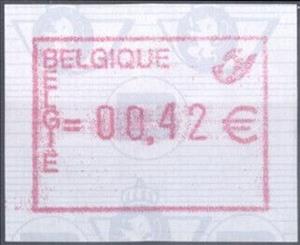Stamp: Without identification number - Euro - Old Safety Paper (Belgium 2001)
Without identification number - Euro - Old Safety Paper (Belgium 2001)
31 December (Belgium ) within release ATM Labels goes into circulation Stamp Without identification number - Euro - Old Safety Paper face value Variable Euro
| Stamp Without identification number - Euro - Old Safety Paper in catalogues | |
|---|---|
| Michel: | Mi: BE ATM47 |
| Yvert et Tellier: | Yt: BE D58 |
| Belgium: | Bel: BE ATM107 |
Stamp is square format.
All values between 0.01 and 99 euro are possible. "Official" set consists of 4, 5 or 6 vignettes with the applicable postal rates: S1: 2001-12-31: 4 values: 0.42, 0.52, 0.74 and 0.84 Euro S2: 2002-11-18: 4 values: 0.42, 0.49, 0.52 and 0.57 Euro S3: 2002-12-06: 4 values: 0.41, 0.49, 0.59 and 0.84 Euro S4: 2004-05-03: 4 values: 0.44, 0.50, 0.60 and 0.80 Euro S5: 2004-05-13: 6 values: 0.44, 0.50, 0.55, 0.60, 0.65 and 0.80 Euro S6: 2005-04-04: 6 values: 0.44, 0.50, 0.60, 0.65, 0.70 and 0.80 Euro S7: 2006-02-01: 6 values: 0.46, 0.52, 0.60, 0.65, 0.70 and 0.80 Euro S8: 2007-02-01: 6 values: 0.46, 0.52, 0.70, 0.75, 0.80 and 0.90 Euro S9: 2007-09-01: 5 values: 0.52, 0.70, 0.75, 0.80 and 0.90 Euro S10: 2008-02-04: 5 values: 0.54, 0.70, 0.75, 0.80 and 0.90 Euro S11: 2009-01-01: 4 values: 0.59, 0.90, 1.05 and 1.18 Euro S12: 2010-01-01: 4 values: 0.69, 1.00, 1.15 and 1.38 Euro S13: 2011-01-01: 4 values: 0.71, 1.03, 1.20 and 1.42 Euro S14: 2012-01-01: 4 values: 0.75, 1.09, 1.29 and 1.50 Euro Michel and Yvert make no difference between the sets nor the face valuesStamp Without identification number - Euro - Old Safety Paper it reflects the thematic directions:
A number is a mathematical object used to count, measure, and label. The most basic examples are the natural numbers 1, 2, 3, 4, and so forth. Numbers can be represented in language with number words. More universally, individual numbers can be represented by symbols, called numerals; for example, "5" is a numeral that represents the number five. As only a relatively small number of symbols can be memorized, basic numerals are commonly organized in a numeral system, which is an organized way to represent any number. The most common numeral system is the Hindu–Arabic numeral system, which allows for the representation of any non-negative integer using a combination of ten fundamental numeric symbols, called digits. In addition to their use in counting and measuring, numerals are often used for labels (as with telephone numbers), for ordering (as with serial numbers), and for codes (as with ISBNs). In common usage, a numeral is not clearly distinguished from the number that it represents.

